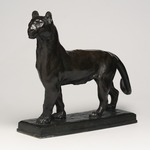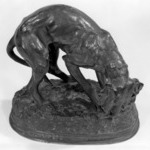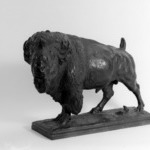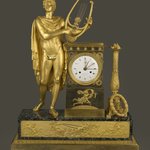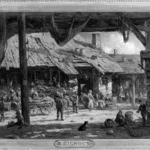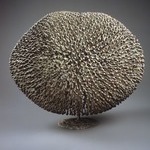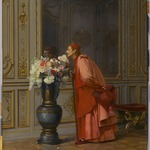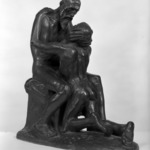
Bacchantes Embracing (Bacchantes s'enlaçant)
European Art
Rodin executed more than half a dozen groups of embracing female lovers in poses of ecstasy and abandon, including Bacchantes Embracing and Damned Women (on view nearby). Although it is not known when this work was titled or by whom, the allusion to mythology placed these passionate figures at a temporal and conceptual remove, thus making the then-taboo subject more acceptable to a conservative audience. Interestingly, one of the women here is not even a bacchante (a follower of the wine god Bacchus), but rather a female faun, identified by her goatlike legs and cloven hooves.
CAST BY
Aage Fersing
MEDIUM
Bronze
DATES
possibly before 1896; cast after 1967
DIMENSIONS
15 × 15 × 11 in. (38.1 × 38.1 × 27.9 cm) (show scale)
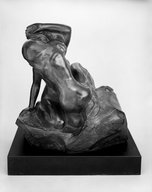


MARKINGS
Near signature: "CIRE PERDUE AF"
SIGNATURE
On rock behind figure with proper right knee up: "Rodin"
INSCRIPTIONS
Rock, side toward which upraised elbow points: "VII/XII"
COLLECTIONS
European Art
ACCESSION NUMBER
84.77.2
CREDIT LINE
Gift of Iris and B. Gerald Cantor
EXHIBITIONS
MUSEUM LOCATION
This item is not on view
CAPTION
Auguste Rodin (French, 1840–1917). Bacchantes Embracing (Bacchantes s'enlaçant), possibly before 1896; cast after 1967. Bronze, 15 × 15 × 11 in. (38.1 × 38.1 × 27.9 cm). Brooklyn Museum, Gift of Iris and B. Gerald Cantor, 84.77.2. Creative Commons-BY (Photo: Brooklyn Museum, 84.77.2_bw.jpg)
EDITION
Edition: VII/12
IMAGE
overall, 84.77.2_bw.jpg. Brooklyn Museum photograph
"CUR" at the beginning of an image file name means that the image was created by a curatorial staff member. These study images may be digital point-and-shoot photographs, when we don\'t yet have high-quality studio photography, or they may be scans of older negatives, slides, or photographic prints, providing historical documentation of the object.
RIGHTS STATEMENT
Creative Commons-BY
You may download and use Brooklyn Museum images of this three-dimensional work in accordance with a Creative Commons license. Fair use, as understood under the United States Copyright Act, may also apply.
Please include caption information from this page and credit the Brooklyn Museum. If you need a high resolution file, please fill out our online application form (charges apply).
For further information about copyright, we recommend resources at the United States Library of Congress, Cornell University, Copyright and Cultural Institutions: Guidelines for U.S. Libraries, Archives, and Museums, and Copyright Watch.
For more information about the Museum's rights project, including how rights types are assigned, please see our blog posts on copyright.
If you have any information regarding this work and rights to it, please contact copyright@brooklynmuseum.org.
RECORD COMPLETENESS
Not every record you will find here is complete. More information is available for some works than for others, and some entries have been updated more recently. Records are frequently reviewed and revised, and we welcome any additional information you might have.





